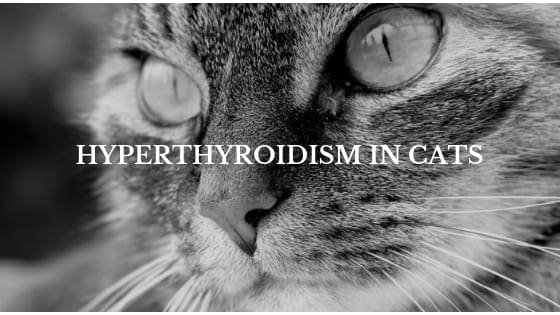What is the Thyroid Gland?
The thyroid gland, which is located in the neck, is responsible for regulation of metabolism. The thyroid affects almost every organ in the body.
Hyperthyroidism
Hyperthyroidism is a high amount of thyroid hormone in the blood. This generally occurs in middle-aged and older cats, and typically appears at around 10-13 years of age.
Signs of hyperthyroidism include:
- Weight loss despite increase in appetite
- Increased activity level
- Increased urination
- Diarrhea
- Aggression
- Nervousness
- Rapid heart rate
- Increased stool
- Muscle weakness
- Poor coat condition
- Vomiting
- Increase in grooming
- Hair loss
Causes of Hyperthyroidism
There has been an increase in the number of cases of hyperthyroidism in cats in the last couple of decades. Reasons may include benign tumors, cancer, ingredients in food and environmental factors.
How is Hyperthyroidism Diagnosed?
Diagnosis is done through blood tests to determine T3 and T4 levels which are the thyroid hormones. T4 (thyroxine) is the main thyroid hormone. Testing of elevated T4 is primarily the way hyperthyroidism is diagnosed. Physical examination that includes palpating the thyroid gland is also done. Normally, the thyroid gland can’t be felt but with hyperthyroidism it becomes enlarged.
Treatment of Hyperthyroidism
There are currently three options for treatment:
- Administration of methimazole, an anti-thyroid drug
- Radioactive iodine treatment
- Surgical removal of the thyroid gland
Your veterinarian will help you decide which of the above treatments would be most appropriate for your cat based on your cat’s current condition, age and your budget requirements. If your cat has other health concerns that would influence whether one treatment is more appropriate than another. If the treatment of using methimazole is chosen, it will be a long-long commitment. The cat will need to receive this drug at least once (and up to three times) a day for the rest of his life.
There is also a therapeutic hyperthyroidism management diet available by prescription. Your veterinarian will advise you on whether that would be an option for your cat.
Want More Information?
If your cat has exhibited any of the signs mentioned above, visit your veterinarian so a proper diagnosis can be made. If you have noticed behavioral changes such as nervousness, irritability or aggression, don’t assume it’s behavioral without having your veterinarian rule out underlying medical causes.
For more information on cat behavior and training, refer to the books by Pam Johnson-Bennett. Pam’s books are available at bookstores and online. We’ve included links to Amazon on our website.
If you have a question about your cat’s behavior or health, contact your veterinarian. This article is not intended as a medical diagnosis nor is it a replacement for your cat’s regular veterinary care. This article is for general information purposes only.
 Problem Solving & Advice by Pam Johnson-Bennett Cat Behavior Expert & Best-selling Author
Problem Solving & Advice by Pam Johnson-Bennett Cat Behavior Expert & Best-selling Author



